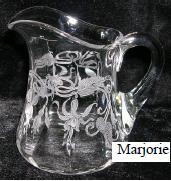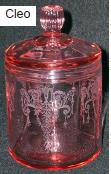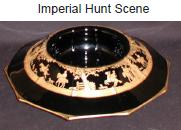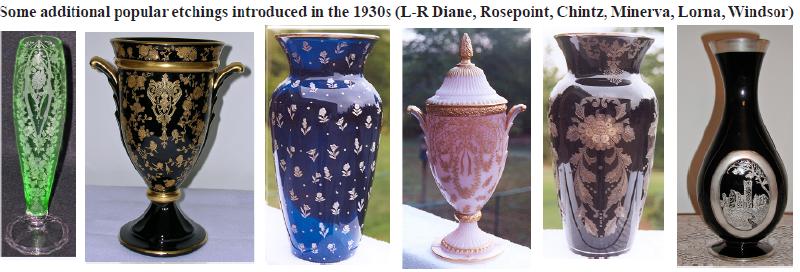Etchings by the Cambridge Glass Company
by David Ray
Issue No. 415 - February 2008
The Cambridge Glass Company started etching glassware around 1912. This etching process was called needle etching or tadding. Needle etching machines were sold to a many of different glass companies, so identical etchings can be found on glassware produced by many different companies. These etchings consisted of designs similar to those produced by a Spiro graph. A needle was used to impart the pattern into the glass. As a result, these etchings are very shallow. Cambridge used about 12 different needle etchings. (Refer to page 98 of The Cambridge Glass Co. A Reprint of Parts of old Company Catalogues by Mary, Lyle and Lynn Welker.)
 Around 1915, the Cambridge Glass Factory switched from needle etching to an acid etching process. At
the end of this article, a detailed description of the acid etching process is given. The major advantage of
the acid etching process was the etching could be more creative and elaborate. The most popular of the
Around 1915, the Cambridge Glass Factory switched from needle etching to an acid etching process. At
the end of this article, a detailed description of the acid etching process is given. The major advantage of
the acid etching process was the etching could be more creative and elaborate. The most popular of the
 early etchings was Marjorie (photo at right). Marjorie was a fuchsia-like etching mainly produced on crystal with only a
few pieces being found on colored blanks. Some of the other early etchings included Martha, Old Fashioned
Grape, Strawberry, E404, E405, E406, E407, and D619. More early etchings likely exist, but records from
this time period are incomplete.
early etchings was Marjorie (photo at right). Marjorie was a fuchsia-like etching mainly produced on crystal with only a
few pieces being found on colored blanks. Some of the other early etchings included Martha, Old Fashioned
Grape, Strawberry, E404, E405, E406, E407, and D619. More early etchings likely exist, but records from
this time period are incomplete.
It appears round 1921-1924 a new wave of etchings was introduced. Some of the more popular etchings from this time period included: Adams, Bordeaux, Chrysanthemum, Classic, Cleo (shown at left), Dragon, Mah-Jong Tiles, Peacock, Early Wildflower, and E704. The majority of these etching can be found on light emerald, amber, pink, ebony, and crystal. Some can be found on a variety of opaque colored blanks. A definite societal change occurred in the early 1920's and colored glassware became very popular.
 The 1927-1929 Catalog introduced a nice selection of new etchings. Some the more
popular etchings included: Golf Scene, Imperial Hunt Scene (photo at right), Majestic, Rosalie, Tulip,
and Willow. The popularity of colored glassware continued into the late 1920's and
nearly all of these etching can be found on light emerald, pink, amber, ebony, and
crystal. Willow can be found on opaque colors. There were several other etchings introduced during this
time period, but many of them are only denoted with an etching number and are typically found on a limited number of items.
The 1927-1929 Catalog introduced a nice selection of new etchings. Some the more
popular etchings included: Golf Scene, Imperial Hunt Scene (photo at right), Majestic, Rosalie, Tulip,
and Willow. The popularity of colored glassware continued into the late 1920's and
nearly all of these etching can be found on light emerald, pink, amber, ebony, and
crystal. Willow can be found on opaque colors. There were several other etchings introduced during this
time period, but many of them are only denoted with an etching number and are typically found on a limited number of items.
With the publishing of the 1930-1934 Catalog and the hiring of Walter Geugold in the mid-1930's as a full-time etchings designer, the 1930's was the decade of the most elaborate and popular of all Cambridge etchings. Geugold was employed by the Cambridge Glass Company until it closed in 1958. The following etchings are some of the popular etchings introduced in the 1930's: Apple Blossom, Blossom Time, Brettone, Candlelight, Chantilly, Chintz, Dancing Girls, Diane, Elaine, Firenze, Gloria, Lily of the Valley, Lorna, Minerva, Portia, Rosepoint, Valencia, Vichi, Wildflower, Windsor, and Ye Olde Ivy. At some point in the 1930's, the popularity of colored glassware greatly declined and etchings were primarily placed on crystal blanks.


The Etching Process
The following is a summary of the acid etching process. An excellent article in the July 2007 issue of the Glasszette published by the Imperial Glass Collectors provided many of the following details. Once a design for an etching was approved, the design was carved into a metal plate. This was known as an etching plate. In order to create an etching plate, a master carver would carefully cut away the background portion of an etching while leaving the actual etching design raised. Depending on the demand for a particular etching, several plates could be made to help increase productivity.
(1) The etching plate was coated with a heavy layer of an acid-resistant (resist) material. This material was typically a mix of lamp black and bee's wax.
(2) After a few minutes, the resist was scraped away leaving the etching pattern exposed while the background remained filled with the resist.
(3) A special tissue-like paper was laid on the etching plate and rubbed to allow the resist to attach to the paper. When the paper was carefully pealed away, the black resist was attached to the paper revealing the etching design.
(4) The excess paper was trimmed and then placed on the item. Because the resist was sticky, it easily adhered to the glass.
(5) The paper was rubbed thoroughly so the resist would stick tightly to the glass. The item sat for several minutes allowing the resist to harden.
(6) In order to remove the tissue-like paper, the item is dipped into denatured alcohol. The alcohol caused the paper to soften and easily fall away.
(7) Except for the area to be etched, the remainder of the object was coated with a thick layer of resist. This protected the glass from becoming etched when it was dipped into the acid bath.
(8) The object was dipped into a hydrofluoric acid and water mixture. The acid etched the exposed glass imparting the etching design.
(9) The object was rinsed with cold water to remove any remaining acid solution.
(10) The object traveled though a machine where it is showered in scalding water. The scalding water melted away the wax-like resist.
(11) The object was dried and packed for shipping.
After reading the many steps used to etch a single piece of glass, you can quickly see how labor intensive the etching process was. In 1980, the Fostoria Glass Company was selling Navarre etched water goblets for around $30/each.
